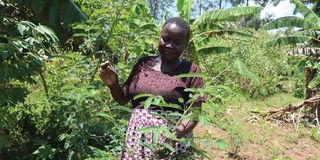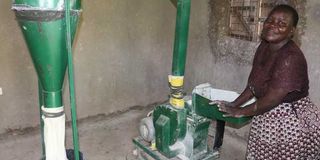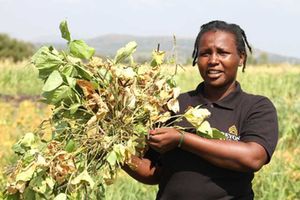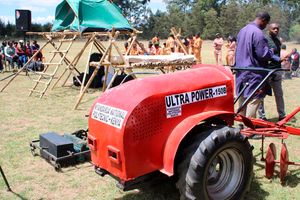
Sesbania plant, which is used as animal feed and a nitrogen-fixing component. It is one of the regenerative agriculture methods adopted by Monica Makokha, a farmer based in Kakamega County.
When Monica Makokha’s husband died way back in 1994, she did not know what the future held.
At just 26 and with five children, the journey ahead seemed rough. “My husband was a civil servant. I took the decision to make farming my office,” Monica says.
She has risen to become a well-known farmer in Kakamega County.
Monica’s 11-acre piece in Itenje Ward, Mumias, has many crops. She has become an expert in producing traditional crops, following in her husband’s footsteps. A portion of her farm is dedicated to tubers.
“I grow coloured sweet potatoes and yams on a large scale,” she says.
The sweet potatoes are the orange and yellow-fleshed varieties, known for their nutritional benefits.
Monica also grows traditional African leafy vegetables like black nightshade (managu or sucha), amaranth (terere), cowpea leaves (kunde) and spider plant (saga). Other crops are sukuma wiki, spinach, bananas, tree tomatoes and avocado.
She produces traditional beans like black beans and mucuna, a cover crop that fixes nitrogen in the soil. Mucuna or velvet bean is a tropical legume native to Africa.
“I have livestock and practise organic farming,” Monica tells the Seeds of Gold, adding that she rears improved kienyeji chickens and indigenous ones, dairy cows and rabbits.

The posho mill at Monica’s farm in Kakamega, which she uses to process the dried tubers and maize.
For more income, Monica adds value to her produce. The farmer dries and processes tubers and fruits.
“Marketing fresh produce is not easy, especially when there is a glut,” she says.
Her efforts have even been recognised by the Kakamega devolved government, which provides her with inputs at subsidised prices.
Monica uses a solar dryer and a miller to process her produce. She began adding value to her yields in 2019 after not-so-good encounters with middlemen.
“I used to suffer heavy losses when buyers failed to turn up and could not store my produce properly,” she says.
Monica peels and dries her harvested yams and potatoes.
“I use a posho mill to blend the dried tubers with maize and create nutritious flour for porridge and ugali. I sell fresh vegetables at Sh25 per kilo at the farm gate, but when dried, the prices go up,” she says.
Monica says she has gained a lot from a partnership with SNV Netherlands Development Organisation, which runs several programmes in the country to support farmers. She relies on solar-powered irrigation installed in 2019.
The NGO has supported her with seeds, fertiliser, other inputs as well as training. SNV says it is committed to building resilient agri-food systems, increasing the reliability and availability of water and sanitation and improving access to affordable and sustainable energy.
It runs two programmes in Western Kenya – the Vegetables for Planet and People Project and Regenerative Agricultural Practices for Improved Livelihoods and Markets.
“Regenerative agriculture is not new. Farmers just need more training to optimise their efforts,” says Kevin Yongo, the SNV Project Field Officer in Kakamega, Vihiga, and Kisumu.
Yongo says there are more than 17 regenerative agriculture technologies, and if farmers could adopt at least five, hunger would become a thing of the past.
The technology includes water conservation, drying technology, soil health improvement, terracing and sunken beds and mulching.
Others are the use of biochar fertiliser, the “push-and-pull” technique using Napier grass to attract armyworms and natural pest and disease management methods. Pests and disease control methods are integrated. Farmers are encouraged to grow pest-repellent crops.
“We train farmers who, in turn, become trainers. The project works with youth and women groups,” Yongo says.
Monica is a member of Itenje Kilimo Biashara Farmers’ Co-operative Society.
The co-op, which started with 10 member, now boasts of more than 100.











